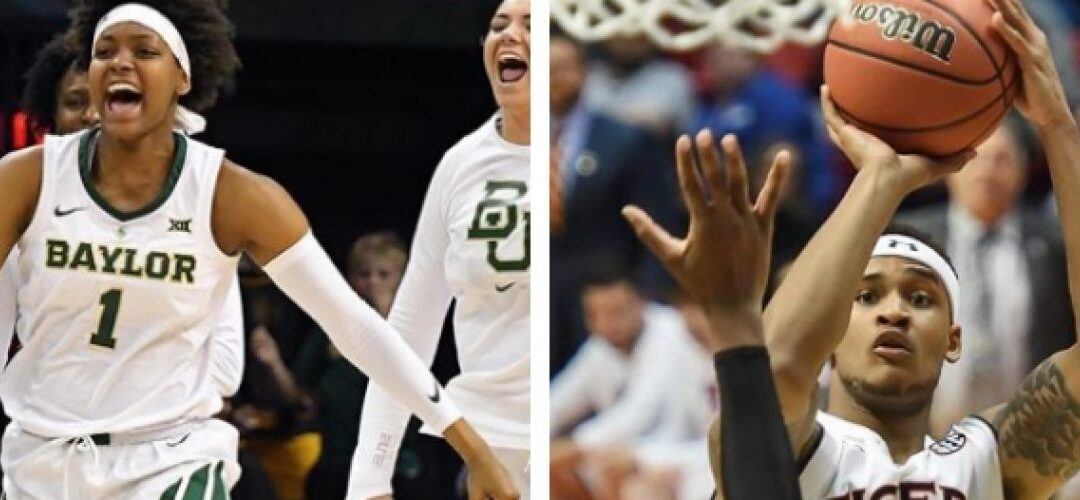By Paul Culp, MA (Oxon.), CFT, GCDF, CCSP
Early spring means March Madness carrying over into April and the NCAA men’s and women’s basketball tournaments nearing their conclusions. College basketball becomes hard to ignore, even for those of us who normally don’t follow it closely. Meanwhile it’s time for high school students pursuing athletic scholarships to get busy registering with the NCAA and NAIA, if they haven’t already—the end of junior year is pretty late in the game—and considering which summer leagues, workshops, camps, clinics, and combines are advantageous for them. Having already published articles about the scholarship stakes in women’s soccer, women’s volleyball, and lacrosse, along with research on athletic scholarships in general (The “How Many” and “How Much” of Athletic Scholarships and The “How To” of Athletic Scholarships Explained), we figure now is a good time to take on basketball.
According to Scholarshipstats.com, one high school athlete in 14 goes on to compete in a varsity sport in college, but only one in 54 makes the grade in NCAA Division I. The largest percentage is in Division III, which does not provide athletic scholarships, but we’ll explain shortly why sports are nonetheless important in the D3 financial aid picture.
About 550,000 high school boys play basketball, while not quite 31,000 male players compete in college. Athleticscholarships.net reports that there are 1,844 men’s teams: 344 in Division I, 282 in Division II, 403 in Division III, 250 in the NAIA, and 560 among junior colleges. The odds of playing at college level are about 17:1, which doesn’t sound too bad—but only .9 percent of male high school basketball players eventually compete in Division I, and the same percentage in Division II. The Division III programs account for 1.3 percent, the NAIA .8 percent, and junior colleges 1.7 percent. The odds of going pro? 1,860:1, more than three times longer than in football.
Of the 430,000 high school girls playing basketball, about 27,000 compete in college, on 1,834 teams: 335 in Division I, 298 in Division II, 426 in Division III, 256 in the NAIA, and 519 among junior colleges. The odds of playing at college level are about 16:1, with 1.1 percent of high-schoolers making it to Division I and the same in Division II, 1.5 percent in D3, .8 percent in the NAIA, and 1.7 in juco. Generally things look just a tiny bit more promising for the ladies, except that the odds of a woman going pro are 3,406:1.
For this great throng of high-school cagers (am I the only one who remembers that quaint term for basketball players?) there are 9,504 scholarships altogether for men and 10,165 for women, according to Scholarshipsstats.com, about one for every 57 male high school basketball players and one for every 43 females. But here, as in the other sports we’ve written about, it’s necessary to explain that not all scholarships are created equal. Much confusion arises on this point as athletes and their parents pursue scholarships and either count their blessings or curse their luck, or sometimes do the latter shortly after doing the former, having read the fine print in the meantime.
Not all sports are head-count sports, meaning sports in which scholarships are awarded at a ratio of one full scholarship per athlete. Far more common are equivalency sports, in which coaches can divide one scholarship among as many athletes as they see fit.
Blessed are the Division I basketballers, for the NCAA requires that those scholarships be awarded on a head-count basis. Each men’s program is allowed 13 and each women’s program 15. The average men’s scholarship is worth about $16,000, the average women’s scholarship about $17,000. This continues a pattern we have observed in other sports, and indeed women overall receive more per athlete than men do throughout college athletics as a whole.
After Division I, the joy fades rapidly. D2 has a scholarship limit of 10 for each gender, with the average value for men being $6,300 and for women $7,700. The NAIA has a limit of 11 per team, at an average of $7,300 for men and $7,700 for women. The NJCAA limit is 15 per team, with an average of $2,500 for men and $3,000 for women. And remember: At every level but Division I, coaches can distribute a scholarship among multiple athletes.
Remember also that the scholarship limit is per program, not per year. The number of players returning can limit the number of scholarships available for incoming freshmen, and in every category but Division I can affect how and whether a scholarship is distributed among multiple athletes.
As we pointed out in our oft-cited An Arm and a Leg and Your First-born Child: Why College Costs So Much, the average cost of tuition and fees for the 2017–2018 school year was $34,740 at private colleges and universities, $9,970 for state residents at public institutions, and $25,620 for out-of-state residents attending public institutions. Compare that with the scholarship averages above, and take note that athletic scholarships do not exclude other forms of financial aid.
Now, what of NCAA Division III? While Division III programs do not offer athletic scholarships, sports can still be a ticket to financial aid, a component of an extracurricular resume that colleges consider strongly in making decisions about whom to admit and whether to bestow financial aid. Thus it is possible, even without athletic scholarships, for athletic prowess and the desire to perform at the college level to play a role in the acquisition of financial aid for student-athletes applying at Division III schools.
Basketball scholarships, like other scholarships, usually go to people who are strategic.
We at The Coaching Educator don’t want to throw cold water on anybody’s hopes, or take the luster off their rejoicing, but our realistic assessment of the basketball scholarship scene helps underscore the importance of having a strategy not only for pursuing athletic scholarships but also for combining them with other forms of financial aid. We’re here to help students and their families make sense of an increasingly complicated procedure and find ways to overcome the ever-increasing expense of college for athletes and non-athletes alike.
To learn more about our philosophy and capabilities, be sure to watch our free webinars, listen to our podcasts, sign up for our four-week College App Boot Camp, consider our Ultimate Programs and our special services for athletes and performing-arts students, and book a consultation to hear what we can do for you and how we do it. Keep reading this blog, and look for us on social media (see links in “Credits and Recommendations” below) as we keep our clients and admirers advised of new developments in our effort to help students get into and succeed at the right school.
Paul Culp is certified as a global career development facilitator and writes about college admissions, college costs, financial aid, and college life in general for The Coaching Educator team. A former journalist and corporate ghostwriter who now operates Shenandoah Proofreading, Editing & Composition Services (SPECS), he has been a humanities teacher at all levels from university down to sixth grade. Paul has degrees from Oxford University, Jacksonville State University, and Samford University, and also is certified as a fitness trainer.
Photo Credits
Photos: Baylor Lady Bears basketball and Wade Rackley of Auburn Athletics
Recommended Reading About College Admissions and Athletic Scholarships
Culp, Paul. “An Arm and a Leg and Your First-born Child: Why College Costs So Much,” The Coaching Educator, 6 September 2018, http://tce.local/2018/09/06/an-arm-and-a-leg-and-your-first-born-child-why-college-costs-so-much/
Culp, Paul. “The ‘How Many’ and ‘How Much’ of Athletic Scholarships,” The Coaching Educator, 18 September 2018, http://tce.local/2018/09/18/the-how-many-and-how-much-of-athletic-scholarships/
Culp, Paul. “The ‘How To’ of Athletic Scholarships Explained,” The Coaching Educator, 24 November 2018, http://tce.local/2018/11/24/the-how-to-of-athletic-scholarships-explained/
Culp, Paul. “Lacrosse Scholarships by the Numbers,” The Coaching Educator, 6 December 2018, http://tce.local/2018/12/06/lacrosse-scholarships-by-the-numbers/
Culp, Paul. “Why Scholarship Athletes Quit,” The Coaching Educator, 25 February 2019, http://tce.local/2019/02/25/why-scholarship-athletes-quit/
Culp, Paul. “Women’s Soccer Scholarships by the Numbers,” The Coaching Educator, 23 October 2018, http://tce.local/2018/10/23/womens-soccer-scholarships-by-the-numbers/?fbclid=IwAR1tqZ-uyy8Kjw8krJDl–ERyuxUF_lt2uVfcqFqbNtmQDDTQvvBK7EOhJ8
Culp, Paul. “Women’s Volleyball Scholarships by the Numbers,” The Coaching Educator, 10 October 2018, http://tce.local/2018/10/10/womens-volleyball-scholarships-by-the-numbers/

